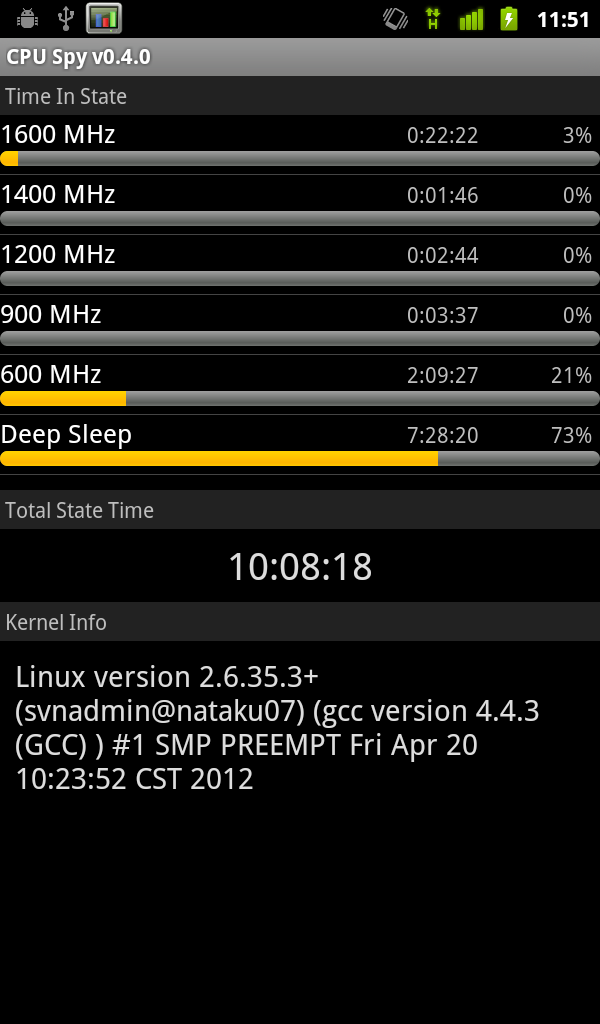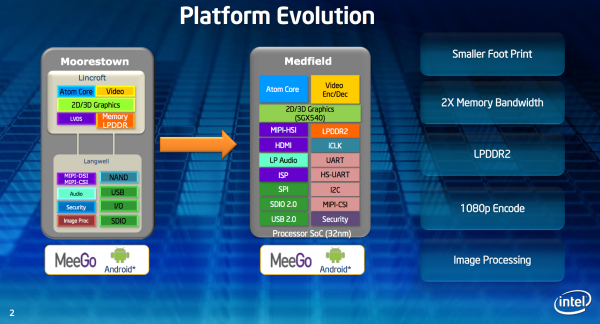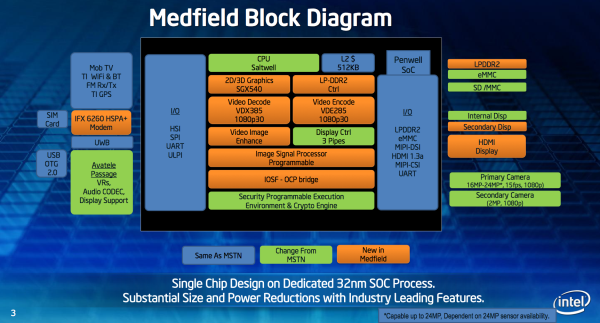Lava Xolo X900 Review - The First Intel Medfield Phone
by Brian Klug on April 25, 2012 6:00 AM ESTMedfield: Intel in a Smartphone
I touched on this before but there were a number of reasons we never saw Moorestown in a smartphone. One part of the problem was the number of packages required to implement the platform, the other was that it simply lacked some of the things that smartphone OEMs implicitly expect to live on an SoC. The internal Intel guidance was that Moorestown required 2 packages to implement (Lincroft and Langwell), and in addition to those two you needed an external PMIC and DRAM. There wasn’t support for PoP memory, only external LPDDR1, and there was only support for 5 MP camera and 720p encode.
Medfield builds in every way on top of this by delivering a bona fide SoC with PoP LPDDR2 (2 x 32 bit support), improved ISP from Intel’s Silicon Hive acquisition, video encode and decode blocks from Imagination, SGX 540 graphics at 400 MHz, additional I/O, and an external Avatele Passage PMIC (Intel calls this an MSIC). The result is a platform that looks to an OEM like any of the other competitors - it’s a combination of SoC, PMIC, and some PoP LPDDR2, as opposed to the previous solution which required two additional external packages. Intel has a few slides online about this evolution and how things have moved inside the single Medfield package, and the result again is something that finally looks like any one of countless ARM-based SoCs.
The specific part inside the X900 is an Atom Z2460 32nm SoC (the platform is Medfield, Penwell is the SoC, and the CPU inside is a Saltwell), and inside a Penwell is the Atom Saltwell core running at up to 1.6 GHz with 512KB of L2 cache, a PowerVR SGX 540 GPU at 400 MHz, and a dual channel LPDDR2 memory interface. Anand has already written about the CPU architecture itself pretty comprehensively, and how it compares to ARM’s Cortex A9 and A15 designs. The long and short of it is that Saltwell is still a dual-issue, in-order core with Hyper-Threading support. There’s a 16 stage integer pipeline, no dedicated integer multiply or divide units (they’re shared with the floating point hardware), and in addition to the 512KB L2 cache there’s a separate 256KB SRAM which is lower power and on its own voltage plane. When Saltwell goes into its deepest sleep state, the CPU state and some L2 cache data gets parked here, allowing the CPU voltage to be lowered even more than the SRAM voltage. As expected, with Hyper-Threading the OS sees two logical cores to execute tasks on.
The other interesting thing is support for EIST and additional C states when the device is idle. Dynamic CPU clocks through the linux governor is something absolutely critical for getting a smartphone with acceptable battery life. What’s interesting here is that Penwell’s advertised dynamic range is between 100 MHz and 1.6 GHz with fine grained 100 MHz increments between, in addition to the C6 state where CPU state data is saved in the on-SoC low power SRAM and the platform is basically suspended (deep sleep).
However, the Android governor onboard the X900 only includes a few steps between 600 MHz and the maximum 1.6 GHz burst clock, in addition to C6. You can see this either by inspecting the governor’s available scaling frequencies:
$ cat /sys/devices/system/cpu/cpu0/cpufreq/scaling_available_frequencies 1600000 1400000 1200000 900000 600000 $ cat time_in_state 1600000 233495 1400000 12304 1200000 19780 900000 25801 600000 5306262
Or by using an Android application which inspects exactly this data. I spent a day with the Medfield phone in my pocket and made a note of capturing what the state data was after the day’s end, and the CPU does indeed go into C6 while idle and in the pocket, and spend a lot of time at the minimum 600 MHz clock with some bursts to 1.6 GHz when I’m doing things.


The reality is that most of the smartphone’s time is really spent idling, waking up only to watch some DRX slots or process background tasks. It is curious to me however that Intel isn’t implementing their Ultra-LFM modes between 100 and 600 MHz - it’s possible there’s no voltage scaling below 600 MHz which in turn doesn’t make it worth jumping into these lower clocks quite yet.
Depending on the device’s thermals, Intel’s governor will select between those available frequencies. There actually are four thermal zones in the device, on the back, front, baseband, and SoC itself. The SoC can go up to 90C before you get throttled (which is pretty typical for Intel CPUs), 75 C on the back, 64 C on the front, and 80 C on the modem. Those sound high but aren’t out of the ordinary for some of the other SoCs I’ve seen who have similar thermal management. In addition, if the platform gets too hot, the display brightness will be clamped to 50%.
I have to admit that I did see the display brightness get clamped once as shown above, but only once during a period where I was running the display at 100% brightness and maxing out the CPU. The bottom back of the X900 can indeed get warm, but nothing inordinate or near the thermals that are set in the software management.
Finally, Saltwell supports the same instruction set as Core 2, including SSE3 and Intel 64. We can check this by looking at the CPU flags from cpu_info as well:
processor : 0vendor_id : GenuineIntelcpu family : 6model : 39model name : Intel(R) Atom(TM) CPU Z2460 @ 1.60GHzstepping : 2cpu MHz : 600.000cache size : 512 KBphysical id : 0siblings : 2core id : 0cpu cores : 1apicid : 0initial apicid : 0fdiv_bug : nohlt_bug : nof00f_bug : nocoma_bug : nofpu : yesfpu_exception : yescpuid level : 10wp : yesflags : fpu vme de pse tsc msr pae mce cx8 apic sep mtrr pge mca cmov pat clflush dts acpi mmx fxsr sse sse2 ss ht tm pbe nx constant_tsc arch_perfmon pebs bts nonstop_tsc aperfmperf pni dtes64 monitor ds_cpl vmx est tm2 ssse3 xtpr pdcm movbe lahf_lm arat tpr_shadow vnmi flexprioritybogomips : 3194.88clflush size : 64cache_alignment : 64address sizes : 32 bits physical, 32 bits virtualpower management:
The rest of the Medfield platform we’ll talk about in the appropriate sections, but the big takeaway is that Intel finally has a real x86 SoC for smartphones and tablets. In addition to the Z2460 that we’re looking at in the X900, Intel has two other SKUs which round out the high end and low end. At the low end is the Z2000 which is functionally identical to the Z2460 but with a maximum CPU clock of 1.0 GHz, no HT, and an SGX 540 clock of 320 MHz, and the Z2580 which is clearly targeted at Windows 8 tablets with two Saltwell cores clocked up to 1.8 GHz, and PowerVR SGX544MP2 graphics at 533 MHz for Direct3D 9_3 compliance.












106 Comments
View All Comments
Spunjji - Thursday, April 26, 2012 - link
...so, suddenly it becomes more than mere opinion when you say the opposite? You have to admit you're on shaky ground with that line of argument."Could benefit from being thinner" isn't quite the same as "too thick". I suspect you mean the former?
UltraTech79 - Thursday, April 26, 2012 - link
Its not an opinion when its true. Phones should stay below 1CM thickness, and even 1CM is pretty beefy. Many people will not consider it due to this and not having a real huge advantage anywhere else.When all else is roughly the same, comfort and aesthetics decide a buy.
phoenix_rizzen - Friday, April 27, 2012 - link
1 cm is *way* too thin for anyone with "normal"-sized hands.Compare the aesthetics of holding/using a cordless phone, an office phone, a corded-phone, basically any phone handset other than a cell phone to a cell phone. Which feels more comfortable in your hand to speak into for more than 3 seconds? The one that fits nicely in the palm of your hand, that nicely curves with the natural lines of your hand (aka everything other than a cell)? Or the one with sharp edges, barely 1 cm thick, that requires you to use the muscles in the sides of your hands to grip, leading to cramping if you actually try to, you know, talk, on the phone?
Today's cell phones are too thin, and battery life is suffering for it.
fm123 - Friday, April 27, 2012 - link
Definitely an opinion. If someone wants a keyboard it's going to be over 1 cm. There are people that put their phone in cases and the result is way over 1 cm. The Otterbox Defender is somewhat popular, and the phone becomes almost 3/4 inch thick.FrederickL - Thursday, April 26, 2012 - link
On the general issue of "phone-thinness" rather than this phone in particular no doubt the same people who want the mobile equivalent of an anorexic catwalk model will then start howling about the battery life in their super-thin phone where there is scarcely room for a battery at all, let alone one with decent capacity. Perhaps we should be discussing the fact that some customers' contradictory "want my cake and eat it" demands indicate that the topic should be that some of the customers are too thick rather than the phones.
mrtanner70 - Wednesday, April 25, 2012 - link
I find the "a bigger battery is all we need" argument rather weird in the context of the thickness. It's not like Intel has not already considered this trade off. It's lighter than I expected though.The trouble with reviews like this (and this is not a criticism) is that SOC price is not considered, nor that fact that the mobile industry really would rather Intel, and its monopolistic/margin desires, stay away. Benchmarks (unless paradigm breaking) are not going to change that.
So far, I do not believe Intel has a single true design win, they paid for them all.
menting - Wednesday, April 25, 2012 - link
profit margins for ARM and Intel as a whole company, if this page can be believed, are similarhttp://ycharts.com/companies/ARMH/profit_margin#se...
menting - Wednesday, April 25, 2012 - link
we dont know what that phone will cost in the US, but for a phone that costs $420 with that performance???? ARM will be pissing in their pants right now if it had the performance of A15 on that phone.duploxxx - Wednesday, April 25, 2012 - link
Knowing that it can't keep up against already existing platforms introduced a while ago it is a failure. Don't see any reason why to buy this mobile phone, it doesn't have any added value against any other major competitor.not on price/power/performance.
so it is doomed before it is even released.
lets see what the tablet brings, but it doesn't look good at all. It all starts with the Atom which has never proven to be a good arch.....
A5 - Wednesday, April 25, 2012 - link
For a first attempt (Moorestown was always going to fail, so I don't count it :P) it really isn't that bad. It pretty handily beats the A9-class SoCs from last year while being somewhat competitive with the S4 running ICS. I'm curious to see if the Medfield ICS build gets better performance.I don't know how much Medfield phones will cost, but if it comes over here as a $420 off-contract device, that places it pretty firmly in the mid-range, where it would certainly be pretty competitive with the A9 devices that will be down there.